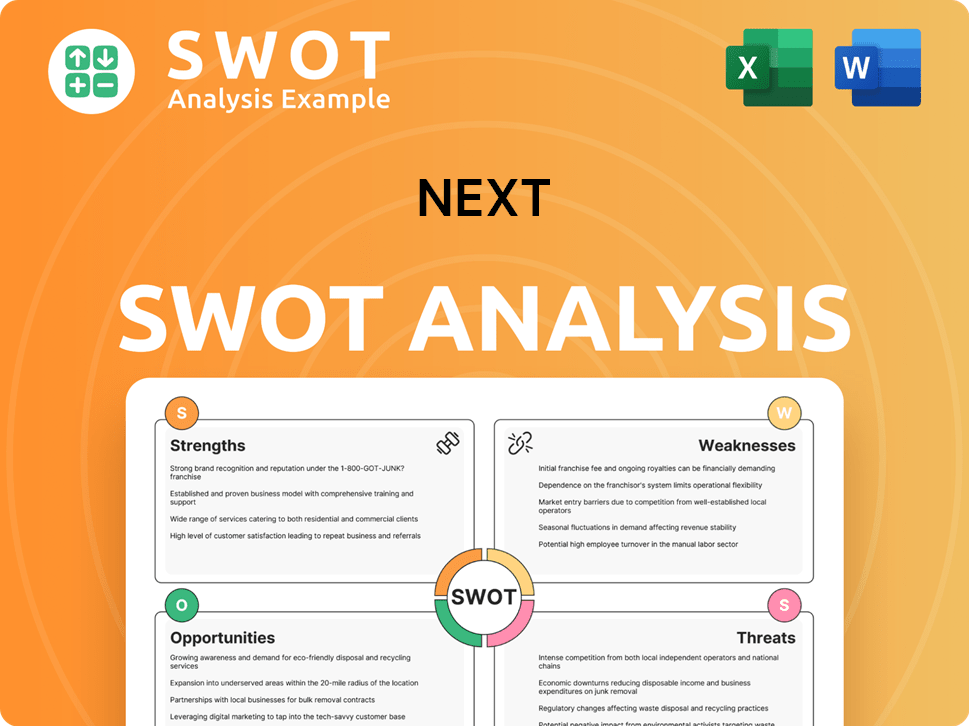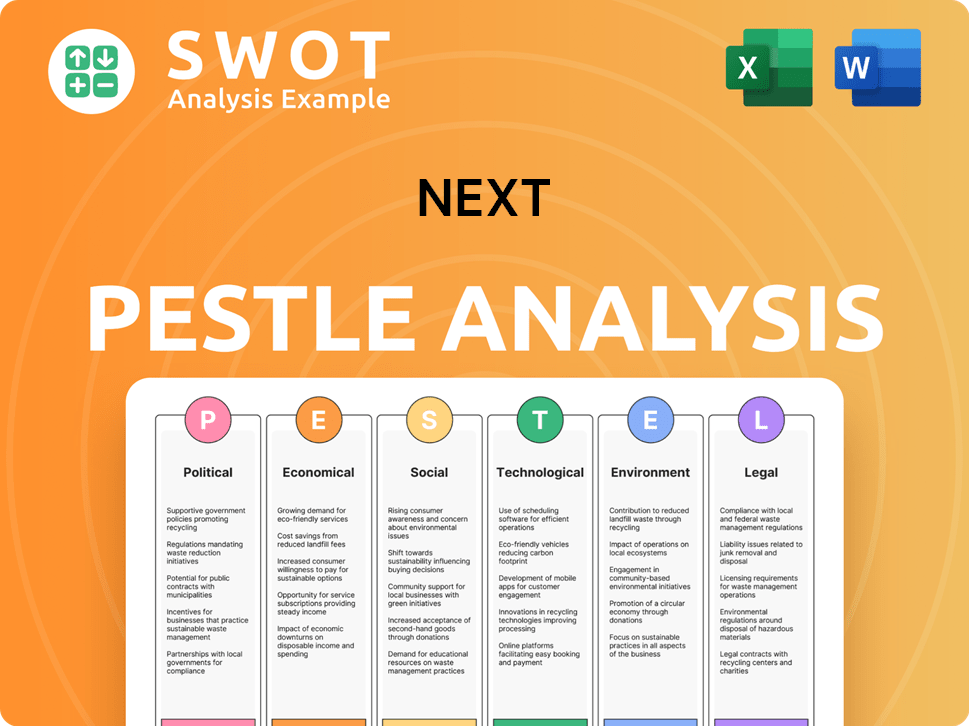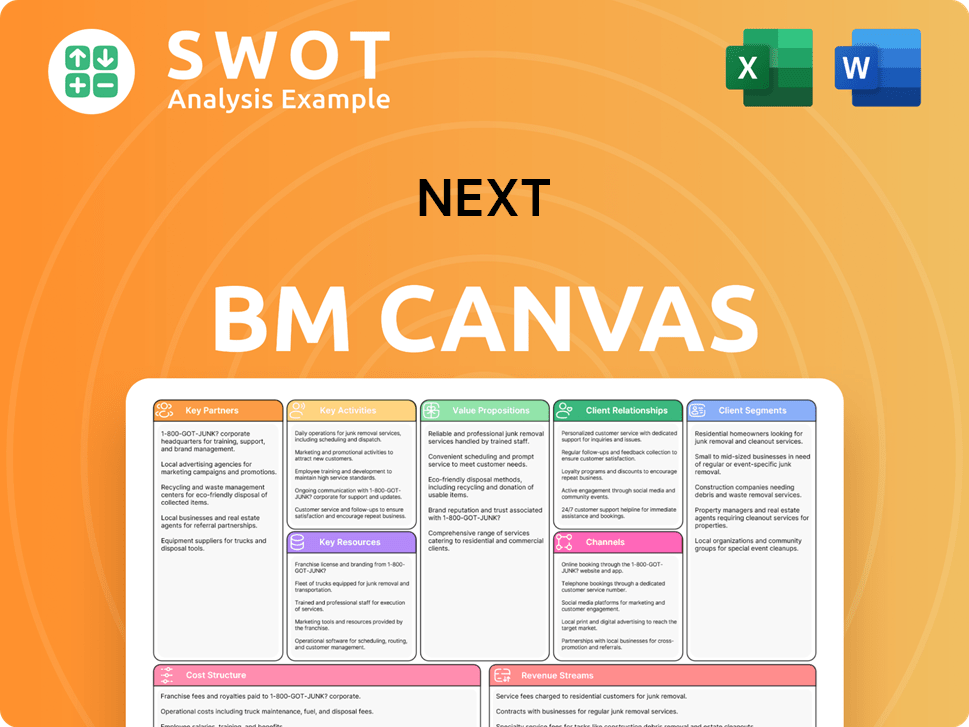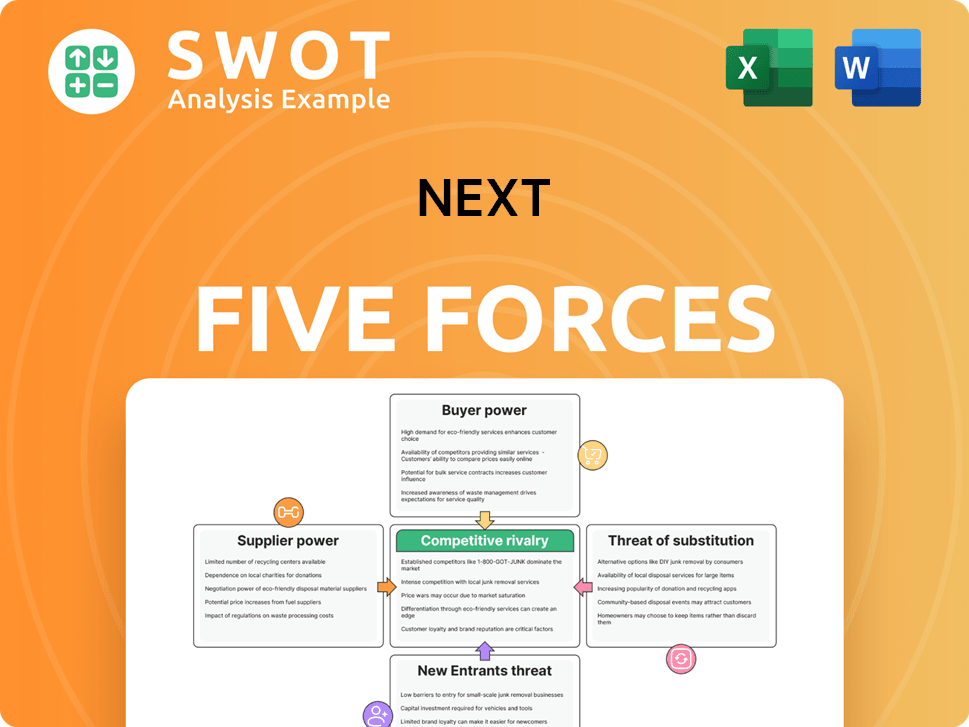Next Bundle
How Did Next Company Rise to Retail Dominance?
From its humble beginnings in 1982, Next plc has become a cornerstone of the British retail landscape. This Next SWOT Analysis will explore the company's journey, revealing the strategic decisions that propelled it to success. Discover how Next Company evolved from a women's fashion retailer to a multi-channel giant, shaping the industry along the way.

Understanding the brief history Next Company offers valuable insights into its enduring success. The Next Company timeline reveals pivotal moments, such as the acquisition of Grattan, which transformed its business model. Explore the company origins and the key events that defined its path, from its founding date to its current market position, and learn about the Next Company founder's vision.
What is the Next Founding Story?
The Growth Strategy of Next began in the early 1980s, marking a significant shift in the UK retail landscape. This transformation was driven by a vision to offer coordinated fashion that combined quality, style, and affordability, a concept that would redefine the shopping experience. This is the brief history of Next Company.
The company's origins trace back to February 1982. The initial focus was on women's fashion, with the launch of the first 'Next for Women' store. This strategic move was pivotal in establishing the brand's identity and setting the stage for future expansion.
The name 'Next' was chosen to reflect a forward-looking approach, signaling a departure from traditional retail models. The early days of Next Company were characterized by innovative retail concepts.
Next plc was founded in February 1982, emerging from the rebranding of the J Hepworth & Son tailoring business. The transformation was spearheaded by George Davies, who identified a gap in the market for coordinated fashion.
- The initial funding came from the existing Hepworth business.
- The first 'Next for Women' store opened in February 1982.
- The company quickly expanded beyond women's clothing to include men's fashion, children's wear, and home products.
- The founding team combined retail experience with a keen understanding of fashion trends.
Next SWOT Analysis
- Complete SWOT Breakdown
- Fully Customizable
- Editable in Excel & Word
- Professional Formatting
- Investor-Ready Format

What Drove the Early Growth of Next?
The Next Company history is marked by rapid growth and expansion from its inception. Following the successful launch of 'Next for Women' in 1982, the company quickly broadened its offerings. This early diversification established the foundation for its future as a comprehensive lifestyle retailer. A key element in the Next Company timeline was the strategic acquisition of the Grattan catalogue business in 1986.
Early product launches, such as 'Next for Men' in 1984 and 'Next Interiors' and 'Next for Children' in 1985, were characterized by coordinated collections. This approach resonated well with consumers seeking a cohesive aesthetic. The company expanded its retail footprint rapidly across the UK, opening numerous stores and establishing a strong high-street presence. The Next Company milestones included the expansion of its retail network.
The acquisition of the Grattan catalogue business in 1986 was a pivotal moment, providing an established direct-to-consumer channel. This significantly expanded its reach beyond physical stores. The company's entry into new markets was primarily driven by its catalogue business, allowing it to reach customers nationwide. This acquisition marked a significant turning point in the brief history Next Company.
Strategic shifts during this period included the aggressive expansion of product categories and the early adoption of direct marketing through its catalogue. Leadership transitions, such as the appointment of David Jones as CEO in 1988, further steered the company through its growth phase. The company's early adoption of direct marketing proved to be a prescient move.
Market reception during this period was largely positive, with the company quickly becoming a popular choice for fashion and home goods. The competitive landscape was dominated by traditional department stores and smaller, specialized retailers. By the late 1980s, the company had firmly established itself as a significant player in the UK retail market, demonstrating robust growth metrics in sales and store count. For more details on the Company origins, you can read further articles.
Next PESTLE Analysis
- Covers All 6 PESTLE Categories
- No Research Needed – Save Hours of Work
- Built by Experts, Trusted by Consultants
- Instant Download, Ready to Use
- 100% Editable, Fully Customizable

What are the key Milestones in Next history?
The Next Company history is marked by several key milestones that have shaped its trajectory in the retail sector. From its company origins to its current standing, the Next Company timeline reflects strategic decisions and adaptations to market dynamics.
| Year | Milestone |
|---|---|
| 1982 | The company was founded, marking the beginning of its journey in the fashion retail industry. |
| 1988 | Next Directory was launched, pioneering a multi-channel retail strategy in the UK. |
| 1999 | Next launched its online retail platform, embracing e-commerce early on. |
| 2008 | The company navigated the financial crisis, adapting to changing consumer spending patterns. |
| 2020-2022 | Next managed the economic impacts of the COVID-19 pandemic, adjusting its operations and strategies. |
Next has consistently embraced innovation to stay ahead in the competitive retail landscape. A significant innovation was the early adoption of a multi-channel retail strategy, integrating physical stores with the Next Directory catalogue.
Next integrated physical stores with a robust catalogue business, Next Directory, offering customers home shopping. This pioneering move set a precedent in the UK retail sector.
Next launched its online retail platform in 1999, becoming one of the first major UK retailers to embrace the internet for sales. This strategic move allowed Next to maintain a competitive edge.
Next has secured numerous patents related to its logistics and supply chain management. This has optimized its delivery and returns processes.
Next has collaborated with various brands through its 'Label' platform. This significantly expanded its market reach and product categories.
Despite its successes, Next has faced various challenges throughout its history, including economic downturns and competitive pressures. These challenges have prompted strategic shifts and adaptations to maintain its market position.
The financial crisis of 2008 and the COVID-19 pandemic significantly affected consumer spending. Next had to adapt to these economic impacts.
Competition from fast fashion retailers and online businesses required continuous adaptation. Next responded by investing in its online infrastructure.
In the late 1990s, the company experienced periods of declining sales and operational difficulties. This led to strategic reassessments.
Next undertook major strategic pivots, including streamlining its store portfolio and diversifying its product offerings. The company also focused on enhancing its financial services division.
Through restructuring, rebranding efforts, and leadership changes, Next has consistently demonstrated resilience. These experiences have instilled a strong focus on operational efficiency.
Next Business Model Canvas
- Complete 9-Block Business Model Canvas
- Effortlessly Communicate Your Business Strategy
- Investor-Ready BMC Format
- 100% Editable and Customizable
- Clear and Structured Layout

What is the Timeline of Key Events for Next?
The Next Company history is marked by significant milestones, from its company origins to its current multi-channel retail presence. Key events in Next Company's history, including the launch of new product lines, strategic acquisitions, and adaptation to the digital age, have shaped its trajectory. The company's evolution over time demonstrates its ability to adapt to changing market dynamics and consumer preferences. The Next Company timeline reflects its journey from a clothing retailer to a diversified retail group.
| Year | Key Event |
|---|---|
| 1982 | Next for Women stores launched, replacing J Hepworth & Son. |
| 1984 | Next for Men introduced, expanding the brand's reach. |
| 1985 | Next Interiors and Next for Children launched, broadening product offerings. |
| 1986 | Acquisition of Grattan plc catalogue business, entering direct sales. |
| 1988 | Launch of Next Directory, a pioneering catalogue business. |
| 1999 | Next launches its first transactional website, embracing e-commerce. |
| 2001 | Introduction of the 'Next One' store concept, combining all product categories. |
| 2008 | Navigates the global financial crisis, demonstrating resilience. |
| 2010s | Significant investment in online infrastructure and international expansion. |
| 2017 | Acquisition of the brand, intellectual property and wholesale business of the Orla Kiely Home and Garden business. |
| 2020 | Responds to the COVID-19 pandemic by rapidly scaling up online operations. |
| 2021 | Next acquires stakes in various fashion and home brands, including Joules and Cath Kidston. |
| 2024 | Next acquires Fat Face for £115.2 million, expanding its portfolio. |
| 2025 | Continues to focus on its multi-channel strategy, leveraging its online platform and retail stores. |
Next plans to further develop its 'Total Platform,' offering e-commerce and logistics services to third-party brands. This initiative is expected to generate an incremental £60 million in profit by 2027. This strategic move leverages Next's existing infrastructure and expertise in online retail and supply chain management.
The company aims to enhance its appeal by expanding its product categories and forming new brand partnerships. This diversification strategy is designed to cater to a broader customer base and increase market share. This approach is crucial in the competitive retail landscape.
Next's long-term strategy includes optimizing its retail estate and investing in technology to improve the online customer experience. These efforts are essential for adapting to the evolving retail landscape and meeting customer expectations. These steps are key to maintaining a competitive edge.
The company is exploring international growth opportunities, particularly through its online channels, leveraging its strong multi-channel capabilities. This focus on digital expansion is critical for reaching new markets and driving future growth. This strategy reflects the importance of adaptability in the retail sector.
Next Porter's Five Forces Analysis
- Covers All 5 Competitive Forces in Detail
- Structured for Consultants, Students, and Founders
- 100% Editable in Microsoft Word & Excel
- Instant Digital Download – Use Immediately
- Compatible with Mac & PC – Fully Unlocked

Related Blogs
- What is Competitive Landscape of Next Company?
- What is Growth Strategy and Future Prospects of Next Company?
- How Does Next Company Work?
- What is Sales and Marketing Strategy of Next Company?
- What is Brief History of Next Company?
- Who Owns Next Company?
- What is Customer Demographics and Target Market of Next Company?
Disclaimer
All information, articles, and product details provided on this website are for general informational and educational purposes only. We do not claim any ownership over, nor do we intend to infringe upon, any trademarks, copyrights, logos, brand names, or other intellectual property mentioned or depicted on this site. Such intellectual property remains the property of its respective owners, and any references here are made solely for identification or informational purposes, without implying any affiliation, endorsement, or partnership.
We make no representations or warranties, express or implied, regarding the accuracy, completeness, or suitability of any content or products presented. Nothing on this website should be construed as legal, tax, investment, financial, medical, or other professional advice. In addition, no part of this site—including articles or product references—constitutes a solicitation, recommendation, endorsement, advertisement, or offer to buy or sell any securities, franchises, or other financial instruments, particularly in jurisdictions where such activity would be unlawful.
All content is of a general nature and may not address the specific circumstances of any individual or entity. It is not a substitute for professional advice or services. Any actions you take based on the information provided here are strictly at your own risk. You accept full responsibility for any decisions or outcomes arising from your use of this website and agree to release us from any liability in connection with your use of, or reliance upon, the content or products found herein.